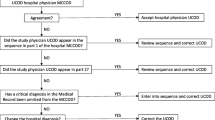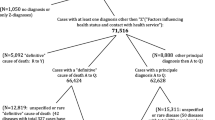Abstract
Objectives
To assess the policy utility of national cause of death (COD) data of six high-income countries with highly developed health information systems.
Methods
National COD data sets from Australia, Canada, Denmark, Germany, Japan and Switzerland for 2015 or 2016 were assessed by applying the ANACONDA software tool. Levels, patterns and distributions of unusable and insufficiently specified “garbage” codes were analysed.
Results
The average proportion of unusable COD was 18% across the six countries, ranging from 14% in Australia and Canada to 25% in Japan. Insufficiently specified codes accounted for a further 8% of deaths, on average, varying from 6% in Switzerland to 11% in Japan. The most commonly used garbage codes were Other ill-defined and unspecified deaths (R99), Heart failure (I50.9) and Senility (R54).
Conclusions
COD certification errors are common, even in countries with very advanced health information systems, greatly reducing the policy value of mortality data. All countries should routinely provide certification training for hospital interns and raise awareness among doctors of their public health responsibility to certify deaths correctly and usefully for public health policy.


Similar content being viewed by others
References
Adair T, Kippen R, Naghavi M, Lopez AD (2019) The setting of the rising sun? A recent comparative history of life expectancy trends in Japan and Australia. PLoS ONE 14(3):e0214578. https://doi.org/10.1371/journal.pone.0214578
AIHW (2018) Australia’s health 2018, Australian Institute of Health and Welfare 2018. Australia’s health series no. 16. AUS 221. AIHW, Canberra. https://www.aihw.gov.au/getmedia/7c42913d-295f-4bc9-9c24-4e44eff4a04a/aihw-aus-221.pdf.aspx?inline=true
Alpérovitch A, Bertrand M, Jougla E, Vidal J-S, Ducimetière P, Helmer C et al (2009) Do we really know the cause of death of the very old? Comparison between official mortality statistics and cohort study classification. Eur J Epidemiol 24(11):669–675
Chammartin F, Probst-Hensch N, Utzinger J, Vounatsou P (2016) Mortality atlas of the main causes of death in Switzerland, 2008–2012. Swiss Med Wkly 146:14280
Civil Registration and Vital Statistics Knowledge Gateway. https://crvsgateway.info/search-filter?s_q_fulltext=ANACONDA
ICD-11 Reference Guide (2019). https://icd.who.int/icd11refguide/en/index.html
Lopez AD (2013) Reducing risks to health: what can we learn from the Global Burden of Disease 2010 Study? Int J Public Health 58(5):645–646
Mahapatra P, Shibuya K, Lopez AD, Coullare F, Notzon F, Rao C, Sretzer S (2007) Civil registration systems and vital statistics: successes and missed opportunities. Lancet 370:1653–1663
Mikkelsen et al (2015) Counting births and deaths 3—a global assessment of civil registration and vital statistics systems: monitoring data quality and progress. Lancet 386:1395–1406
Mikkelsen L, Moesgaard K, Hegnauer M, Lopez AD (2020) ANACONDA: a new tool to improve mortality and cause of death data. BMC Med
Murray CJL, Lopez AD (eds) (1996) The Global Burden of Disease: a comprehensive assessment of mortality and disability from diseases, injuries and risk factors in 1990 and projected to 2020. Global Burden of Disease and Injury Series, vol I. Harvard University Press on behalf of the World Health Organization and The World Bank, Cambridge, MA
Murray CJL et al (2018) Population and fertility by age and sex for 195 countries and territories 1950–2017: a systematic analysis for the Global Burden of Disease 2017. Lancet 392:1995–2051
Naghavi M (2020) Improving the quality of death data for public health policy: are all ‘garbage’ codes equally problematic? BMC Med
Naghavi M, Makela S, Foreman K, O’Brien J, Pourmalek F, Lozano R (2010) Algorithms for enhancing public health utility of national causes-of-death data. Popul Health Metr. 8:9
Philips DE, Lozano R, Naghavi M, Atkinson C, Gonzales-Medina D, Mikkelsen L, Murray CJL, Lopez AD (2014) A composite metric for assessing data on mortality and causes of death: the Vital Statistics Performance Index. Popul Health Metr 12:14
Rampatige R, Mikkelsen L, Hernandez B, Lopez AD (2014) Hospital cause-of-death statistics: what should we make of them? Bull World Health Organ 92:3–3A. https://doi.org/10.2471/BLT.13.134106
Roth GA, Dwyer-Lindgren L (2017) Trends and patterns of geographic variation in cardiovascular mortality among US counties, 1980–2014. JAMA 317(19):1976–1992. https://doi.org/10.1001/jama.2017.4150
Roth GA et al (2018) Global, regional, and national age-sex-specific mortality for 282 causes of death, 1980–2017: a systematic analysis for the Global Burden of Disease Study 2017. Lancet 392:1736–1788
Schdev A et al (2001) Problems with proper completion and accuracy of the cause-of-death statement. Arch Intern Med 161:277–284
Shibuya K (2006) Counting the death is essential for health. Bull WHO 84(3):161–256
World Health Organization (2016) International statistical classification of diseases and related health problems, 10th revision, vol 2, 5th edn. World Health Organization, Geneva
WHO Mortality Database. CoDQL cause of death query online. http://apps.who.int/healthinfo/statistics/mortality/causeofdeath_query/
Wang H, Naghavi M, Allen C, Lopez AD, Murray CJL (2016) Global, regional, and national life expectancy, all-cause specific mortality for 249 causes of death, 1980–2015: a systematic analysis for the global Burden of Disease Study 2015. Lancet 388:1459–544
Funding
Funding was provided by Melbourne Research, University of Melbourne.
Author information
Authors and Affiliations
Corresponding author
Ethics declarations
Conflict of interest
The authors declare that they have no conflict of interest.
Ethical approval
This article does not contain any studies with human participants or animals performed by any of the authors.
Informed consent
No data were collected from individual participants from whom informed consent would be required.
Additional information
Publisher's Note
Springer Nature remains neutral with regard to jurisdictional claims in published maps and institutional affiliations.
Electronic supplementary material
Below is the link to the electronic supplementary material.
Rights and permissions
About this article
Cite this article
Mikkelsen, L., Iburg, K.M., Adair, T. et al. Assessing the quality of cause of death data in six high-income countries: Australia, Canada, Denmark, Germany, Japan and Switzerland. Int J Public Health 65, 17–28 (2020). https://doi.org/10.1007/s00038-019-01325-x
Received:
Revised:
Accepted:
Published:
Issue Date:
DOI: https://doi.org/10.1007/s00038-019-01325-x




